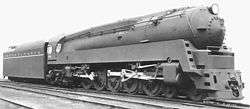Pennsylvania Railroad class Q1
The Pennsylvania Railroad's class Q1 comprised a single experimental steam locomotive for dual service, #6130. PRR Board approved $595,000 for the construction of this experimental Class dual service locomotive on Oct,9 1940, it was built in March 1942, its streamlined shrouding, according to an interview of noted an interview of John W. Epstein, Special Projects Manager and vice president, Raymond Loewy & AssoC., ,[1] was designed by Raymond Lowey, but due to WWII, there was no publicity about it. The Q1 was a duplex locomotive, it had a wheel arrangement of 4-6-4-4, comprising a four-wheel leading truck, two sets of driving wheels (six followed by four) in a rigid locomotive frame, and a four-wheel trailing truck. The first group of six driving wheels was driven by a pair of cylinders mounted conventionally in front of them, while the rear four driving wheels were driven by cylinders mounted behind them on either side of the firebox.[2]
| PRR Q1 | |||||||||||||||||||||||||||||||||||||||||||
|---|---|---|---|---|---|---|---|---|---|---|---|---|---|---|---|---|---|---|---|---|---|---|---|---|---|---|---|---|---|---|---|---|---|---|---|---|---|---|---|---|---|---|---|
 | |||||||||||||||||||||||||||||||||||||||||||
| |||||||||||||||||||||||||||||||||||||||||||
| |||||||||||||||||||||||||||||||||||||||||||
| |||||||||||||||||||||||||||||||||||||||||||
| |||||||||||||||||||||||||||||||||||||||||||
As a locomotive designed for dual service like PRR M1s[3], it was given a larger sized driving wheels at 77 in (1.956 m) which was as large as the Grand Trunk Western class U-4-b 4-8-4 "Northern" type. The Q1's streamlining was in the form of a bluntly pointed nosecone on the smokebox front as well as extended side skirts covering up the locomotive's pipework. The cab front was set at a rakish angle. The tender, although given a freight locomotive's "doghouse" on the rear deck for the head-end brakeman, was otherwise a streamlined affair very similar to that used on the S1, S2, and T1 passenger locomotives. Q1 was the last dual service locomotive designed by Pennsylvania Railroad, but there is no substantial evidence showing that it was assigned to passenger service. Q1's design was able to reduce dynamic argument by 60% compared to the PRR class J above 70mph, but it excessed the railroad's 50mph speed limit for the freight train.[4]
On April 10, 1942, H.W. Jones, Chief of Motive Power, told Altoona that the Q1, #6130, would be considered a passenger engine as far as striping and lettering were concerned.[5] During its short service life, it spent more time in shops or the engine-house than being run, accumulating only about 165,000 service miles in its career (1942–1949).[6] Its first revenue run occurred May 31, 1942, from East Altoona to Enola with 125 cars and 10000 tons, a 40mph was made on a level track at 40% cutoff. [7] In October 1943, it was assigned to the St. Clair Avenue Enginehouse in Columbus, Ohio and ran mostly in the Ohio area and to Chicago, Illinois.
In December 1944 it appeared at a PRR exhibition in Chicago's Union Station entitled "Presenting a Line of Modern Coal-Burning Steam Locomotives." At some time during the next year, it lost much of its streamlining, the nosecone being removed in favor of a conventional PRR smokebox front including the keystone numberplate placed centrally on the small smokebox door. A headlamp bracket mounted above that door also hung the locomotive's bell. The side skirting was cut back to expose pipework and fittings for easier maintenance. The skyline casing atop the boiler remained in place.
The Q1 remained in service until July 1949, after which it was placed in storage. It was dismantled around 1949 and was removed from the company's book in January 1952.
The PRR considered the Q1 design unfit for series production, and railroad historians consider it mostly a failure. The backward-driving rear cylinders were a poor choice; mounted next to the firebox, each constrained the other's size, and the area by the firebox was dusty and hot, which increased cylinder wear. These problems had previously been encountered on the B&O's N-1 duplex. The length of steam pipes required also meant a fair degree of power loss. Added to this, the passenger-locomotive sized drivers were not a good choice for freight service.
From its experiences with this locomotive, the PRR came up with an improved design, the Q2. This had smaller drivers, cylinders mounted in front of the wheels they drove, built largely unstreamlined and was designed for freight service only.
Gallery
 Three quarters view of the Q1.
Three quarters view of the Q1. The Q1 seen from a similar angle, but with most of its streamlining gone. The intricate workings of the duplex drive are easy to see.
The Q1 seen from a similar angle, but with most of its streamlining gone. The intricate workings of the duplex drive are easy to see.
References
Bibliography
- Staufer, Alvin (1962). Pennsy Power. Staufer. pp. 216–225. LOC 62-20872.
- Brian Reed (June 1972). Loco Profile 24: Pennsylvania Duplexii. Profile Publications.
- Eric Hirsimaki (June 1997). "Black Gold - Black Diamonds: The Pennsylvania Railroad & Dieselization" Volume 1. Milesposts Publishings.
- Neil Burnell (2006). Keystone Magazine Vol 39, Number 2. PRRT&HS.
- Harley, E.T. (1982). Classic Power 5: Pennsy Q Class. Hicksville, New York: N.J. International. ISBN 0-934088-09-8.
Citations
- Keystone magazine vol. 26, number 3, Autumn 1993
- Staufer, Alvin (1962). Pennsy Power. Staufer. pp. 216–225. LOC 62-20872.
- Black Gold - Black Diamonds: The Pennsylvania Railroad & Dieselization" Volume 1 by Eric Hirsimaki, July 1997, Page 109 to 112
- Black Gold - Black Diamonds: The Pennsylvania Railroad & Dieselization, Volume 1 by Eric Hirsimaki, July 1997
- The Keystone Magazine Volume 39, Number 2, Page 30
- Keystone magazine, vol. 39, no. 2, p. 30
- Keystone Magazine Volume 39, number 2 | page 18